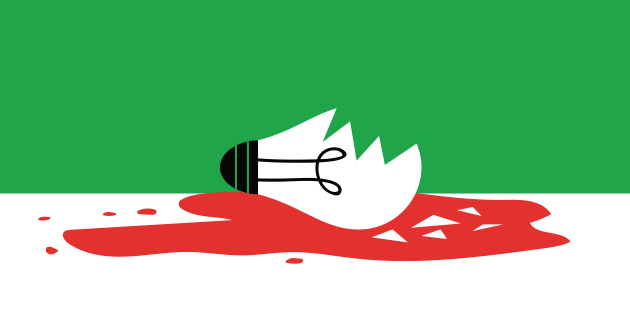
by Robyn Bolton | Apr 13, 2022 | Innovation, Leadership
Do you remember the 2010s? The US economy was in its most prolonged ever period of expansion. Unemployment was at a 50-year low, and there were 110 months of uninterrupted job gains.
Everyone talked about innovation.
Entrepreneurs worked at it, and their startups became unicorns while they became celebrities.
The big companies, the companies with capital, scale, and resources far exceeding that of any startup or even a unicorn, only played with it.
Sure, they hosted hackathons and shark tanks, spun up innovation teams and corporate venture capital arms, and took field trips to Silicon Valley and Burning Man. But what do they have to show for it? What market (re)defining value came from all that activity?
Nothing.
Because it’s nearly impossible to change when you have no immediate need to change.
Too often, success stifles innovation.
But leaders can change that.
Keep innovation on your RADAR
As a manager, you need to deliver today’s business by keeping costs down and revenue up.
As a leader, you want to establish a legacy of long-term success that fuels the business and inspires your people long after you’ve moved to your next role.
The key to achieving both is through the daily practice of innovation. While many leadership behaviors create a culture of innovation and drive business results, I’ve found that RADAR is a handy acronym for some of the key practices of top leaders.
Redefine Innovation
Innovation is something new that creates value. Most people interpret this to mean that innovation is a new to the world product that makes billions in revenue. And while that may be true, it’s much too myopic.
“Something” could be anything from a product to a process, service, revenue model, or delivery model. “New” could be new to the world or your industry, company, function, or team. “Value” could be more revenue or lower costs, higher profits, a better/faster/cheaper/easier experience, or even greater customer or employee satisfaction.
By expanding the definition of innovation, you invite more people into its practice and create more opportunities for innovation to thrive.
Ask Questions
As a leader, it’s natural to feel like you need to have the answers. And sometimes, you do. But often, it’s more vital for you to ask the right questions.
By asking questions, you’re teaching your people to think and take ownership of their work. You’re also demonstrating that you trust them because they are closer to the work than you are. If all you give are answers, you won’t get any wiser, and neither will your team. If you ask questions, everyone, including you, will get smarter and make better decisions.
Discuss Options
When faced with a problem, it’s tempting to jump right to a solution. But if you jump too soon, you could jump to the wrong solution or create an even bigger problem.
Instead, fall in love with the problem. Explore it, question it, embrace it, amplify it, turn it inside out, take it to the extreme. Then, once you’ve embraced the mess that is the problem, play with possible solutions – how would a different industry solve the problem, what if you focused on solving only one key aspect, how could you make it worse?
Yes, this will be uncomfortable (which is why it’s ok to timebox the exercise), but it will also push your team’s thinking and uncover options you never knew existed.
Act Imperfectly
Some lessons can only be learned through experience. As a kid, you know the burner on the stove is hot, but you don’t fully understand how hot it is until you put your hand on it (and then you never forget)
Imperfect action is always a better teacher than perfect inaction. Yes, you need to do the research and conduct the analysis, but eventually, there comes the point when doing is a better way to learn.
Reflect on Lessons Learned
You build knowledge through instruction and skills through experience, but you don’t lock those things in and convert them into habits until you reflect on what you heard and did.
Set your team up to learn at the start of a project by asking what they expect will happen and why, what they’ll do if they’re right, and what they’ll do if they’re wrong. No judgment, no keeping score, just an exercise to prime you and your team for learning
At the end, reflect on the journey. Ask what went right, what went wrong, what went as expected, what didn’t, what we would do differently, and what will we change. Record the answers without judgment and create a plan to put them into action on the next project
How will you keep innovation on your RADAR?
Building innovation habits is key to ensuring that success doesn’t stifle innovation. Daily habits like those in RADAR will make amplifying and unleashing innovation easier.
I’d love to hear what other innovation habits you practice. How do you keep innovation on your RADAR?

by Robyn Bolton | Mar 29, 2022 | Innovation, Leadership, Metrics, Strategy
“We need to be more innovative.”
How many times have you said or heard that? It’s how most innovation efforts start. It’s a statement that reflects leaders’ genuine desire to return to the “good ol’ days” when the company routinely created and launched new products and enjoyed the publicity and growth that followed.
But what does it mean to “be more innovative?”
Innovation’s ABCs
A is for Architecture
Architecture includes most of the elements people think of when they start the work to become more innovative – strategy, structure, processes, metrics, governance, and incentives.
Each of these elements answers fundamental questions:
- Strategy: Why is innovation important? How does it contribute to our overall strategy?
- Structure: Who does the work of innovation?
- Process: How is the work done?
- Metrics: How will we know when we’re successful? How will we measure progress?
- Governance: Who makes decisions? How and when are decisions made?
- Incentives: Why should people invest their time, money, and political capital? How will they be rewarded?
When it comes to your business, you can answer all these questions. The same is true if you’re serious about innovation. If you can’t answer the questions, you have work to do. If you don’t want to do the work, then you don’t want to be innovative. You want to look innovative*.
B is for Behavior
Innovation isn’t an idea problem. It’s a leadership problem.
Leaders that talk about innovation, delegate it to subordinates and routinely pull resources from innovation to “shore up” current operations don’t want to be innovative. They want to look innovative.
Leaders who roll up their sleeves and work alongside innovation teams, ask questions and listen with open minds, and invest and protect innovation resources want to be innovative.
To be fair, it’s incredibly challenging to be a great leader of both innovation and operations. It’s the equivalent of writing equally well with your right and left hands. But it is possible. More importantly, it’s essential.
C is for Culture
Culture is invisible, pervasive, and personal. It is also the make-or-break factor for innovation because it surrounds innovation architecture, teams, and leaders.
Culture can expand to encourage and support exploration, creativity, and risk-taking. Or it can constrict, unleashing antibodies that swarm, suffocate, and kill anything that threatens the status quo.
Trying to control or change culture is like trying to hold water in your fist. But if you let go just a bit, create the right conditions, and wait patiently, change is possible.
Easy as 123
The most common mistake executives make in the pursuit of being “more innovative” is that they focus on only A or only B or only C. But, as I always tell my clients, the answer is “and, not or.”
- Start with Architecture because it’s logical, rational, and produces tangible outputs like org charts, process flows, and instruction manuals filled with templates and tools. Architecture is comforting because it helps us know what to do and how.
- Use Architecture to encourage Behavior because the best way to learn something is to do it. With Architecture in place (but well before it’s finished), bring leaders into the work – talking to customers, sharing their ideas, and creating prototypes. When leaders do the work of innovation, they quickly realize what’s possible (and what’s not) and are open to learning how to engage (behave) in a way that supports innovation.
- Leverage Architecture and Behavior to engage Culture by creating the artifacts, rituals, and evidence that innovation can happen in your company, is happening and will continue to happen. As people see “innovation” evolve from a buzzword to a small investment to “the way we do business,” their skepticism will fade, and their support will grow.
Just like the Jackson 5 said
ABC, It’s easy a 123
Architecture, behavior, culture – they’re all essential to enabling an innovation capability that repeatedly creates new revenue.
And while starting with architecture, building new leadership behaviors, and investing until the culture changes isn’t easy, it’s the 123 steps required to “be more innovative.”

by Robyn Bolton | Mar 16, 2022 | Innovation, Leadership, Strategy
Imagine that you decided to temporarily shut down your business. You made this decision because you knew something major could go wrong and, despite some efforts, you didn’t make as much progress as you hoped. So, you temporarily closed without knowing how long “temporarily” would be.
Three months later, you have made big changes. Massive, ginormous, monumental changes. Changes to foundational elements of your business. You discontinued a beloved product, made existing products safer and expanded a controversial product.
Now, imagine that the press followed all of this. They reported on every meeting, speculated on every discussion, and critiqued every statement. They even said you should be fired.
But now, today, you announced that you’re open for business. All the problems are solved, and all the changes rolled out. The press celebrated, and articles, podcasts, and news stories heralded your business’ re-opening.
Your customers yawned.
They didn’t miss you.
Many didn’t even know you were gone.
A True Story
You just read the story of Major League Baseball at the end of its 99-day lockout.
But it could also be the story of your business if you make the same mistake MLB did in December, which is the same mistake it has made for the past 20+ years.
It forgot what business it’s in.
MLB thinks it’s in the baseball business. For some customers, diehard fans, it is. But for most, baseball is in the business of helping customers to:
- Make memories
- Have fun
- Feel connected to others
- Be entertained
- Drink beer and eat junk food without guilt
These are the Jobs to be Done that customers hire baseball to do for them. But there are dozens of other businesses offering to do the same Jobs, many in ways that are lower cost and more easily accessible. And fans are taking their business to those competitors.
According to Statista, the average per game attendance was 18,900 in 2021, a 34% decline from 2019. Even more troubling than this “generational low” is that people aren’t even watching baseball at home, evidenced by the 12% decline in TV viewership for games.
Customers are rejecting baseball. They just don’t care about it as much as they used to. As a result, they’re spending less time and less money on it and finding newer and better alternatives.
3 Questions to Figure Out if You’re Out (or In)
This story isn’t unique to MLB. It’s the story at the core of many failed businesses. The outward view of solving customers’ problems gives way to an increasingly inward-facing view of the business the business is in.
The story isn’t fast-paced or obvious, either. The declines happen slowly – average gameday attendance dropped only 367 people annually from 2012 to 2019, a decrease that’s easy to miss when considering that the average MLB ballpark holds 43,000 people.
But once the decline starts and apathy sets in, it is challenging to change the story. But not impossible.
If you want customers to care about you again, to need you and your products the way they used to, you need to care more about your customers than your business. You need to ask three questions:
1. “Why do you choose us?” (in Innovation-speak this translates to, “What are your Jobs to be Done?”)
2. “When you don’t choose us, who do you choose and why?”
Then you must listen. Really listen. To EVERYTHING customers say. The reasons you want to hear and the ones you don’t, The competitors you know and the ones you least expect. The things that make them better that you know and the ones you don’t agree with.
Then, and only then, do you look inward at your operations and business model and ask.
3. “What business are we in?”
Are your operations set up to deliver delight to customers or maximum efficiency to your business? Is your business model set up to create value for customers or maximize profit for you? Are you increasing the size of bases 3 inches and claiming its safer or doing everything possible to reduce the game’s length and increase its fun factor?
It’s not customer rejection that kills a business. It’s customer apathy.
Don’t allow your customers to become apathetic. They cared about your business once. Keep giving them reasons to care by asking what they care about and delivering it.
How do you make sure that you’re in the right business?

by Robyn Bolton | Mar 8, 2022 | Innovation, Leadership
When you were a child, you knew that the best stories began with “Once Upon a Time” and end with “And they lived happily ever after.” As an adult, you know that stories can begin and end any number of ways.
As a leader trying to grow a business, it may seem like all your innovation stories end with “And then we cancelled the project/disbanded the team/got distracted by the needs of our current business”
Why is that?
How can you change your innovation story the endings to “And they lived happily ever after (because they launched lots of cool new stuff that people loved and paid for and that led to new revenue and lots of growth and happy employees and other wonderful happy things)”
While there are hundreds, if not thousands, of answers to those questions, one of them is in the way you start the story.
How the story begins
Think about the last time you kicked off an innovation project. What did you say?
Story 1: “We need you to work on X and we don’t want you to be encumbered by what we’ve done in the past. We want you to explore, think creatively, and really push our thinking.
Story 2: “We need you to work on X and, to save you time, here is everything we did in the past. Use this as a starting point and build from here.
Story 3: We need you to work on X. Here’s what we did in the past, but we’re not tied to it. Look it over and let me know what you think we should do from here.
There’s nothing obviously wrong with any of these.
Just like “Once upon a time,” they start with clear direction – we need you to work on X. Even better, they all express your positive intentions and support (push our thinking, save you time, let me know what you think) for the team.
What could possibly go wrong?
How the story ends
The team returns from their quest, which usually involves a lot of research, to present their findings and recommendations. They are excited by what they discovered and eager to continue their work. They conclude their presentation and turn to you, eagerly awaiting your response.
If you started with #1
Thinking of all the freedom you gave at kickoff, and sigh. “That’s good work but we already knew most of that. We wanted you to push our thinking, but I don’t see a lot of new here.”
The team nods and tries to point out the new insights but to no avail. The gather their things and walk out. At best they feel dejected, like they failed an important test. At worst, they’re angry, feeling like the whole exercise was a trap. They know you’re disappointed and, as a result, the end is near.
If you started with #2
Thinking back to the dozens of files you gave them at kick-off, you lean forward and say, “That’s good work but we already knew most of that. To be fair, you built on what we had but why did it take so long?”
The team looks at each other, trying to hide their confusion. They built on what you gave them and delivered it on time. Not knowing quite what to say, they gather their things and walk out. Frustrated, they feel like they were set up to fail. After all, why would you give them so much time if you didn’t want them to use it? They know you’re frustrated too and brace themselves for the repercussions.
If you started with #3
You think back not to the kickoff but to the meeting after that, the one where the team presented their research plan. You take a deep breath and say, “That’s good work but we already knew most of that. To be fair, you did warn me that might be the case. I can see where some things shifted and where we gained new insights.”
The team nods and lays out the implications of their findings. They layout the milestones between today and a potential launch, and detail next steps to hit the next milestone. As before, you debate the insights and the plan, ultimately coming to agreement on what happens next. The team gathers their things and leaves the room, motivated to continue their work
What went wrong?
Three stories began but only 1 is on track for a “happily ever after.” The first two stories began with such promise, but they ended with dejection, anger, disappointment, confusion, and frustration. Why?
Unrealistic expectations
If you started with #1, you set unrealistic expectations. As a leader in the organization, you know more about the business than the team so it’s not realistic to expect the team to tell you something you don’t know. As someone with years of experience in the industry, you know that things don’t change overnight so even research that’s a few years old is still probably more right than wrong. Expecting the team to “push your thinking” and tell you something you don’t know isn’t realistic. Worse, it’s not fair.
Orders, not ownership
If you started with #2, you made it very clear from the start that you’re the expert by telling the team to take past work as a given and build on it rather than question it. You probably also gave them a timeline and told them to come back to you at the next milestone. You did all this to help the team work efficiently and you wanted them to feel ownership, to question the work and take the time they need, even if it’s less than the time given. But the team did exactly what you asked because you gave them orders and, in most companies, success comes from following orders.
What went right?
What did you do in #3 that put the team on path to “happily ever after?”
You were honest and transparent about past work. By sharing past work, you made it clear that you trusted the team to think critically and creatively, to analyze past data and make decisions about what should be kept, questioned, and discarded.
You invited the team to challenge you. When you shared the past work, you gave the team insight into your current hypotheses and biases. By admitting that you’re not tied to past work, you made it clear to the team that you were open to discussion and willing to change your mind.
You empowered the team to take ownership. By asking the team to review past work then come back to you with suggestions and plan, you gave them ownership of the process. When they left that first meeting, they were responsible for the work AND how the work got down. They were project owners now
The End (almost)
Good intentions aren’t enough to set innovation projects and teams up for success. How you start the story by setting expectations and empowering the team has a huge impact on how the story progresses and whether or not it ends “happily ever after.”
How do you start your stories?

by Robyn Bolton | Feb 13, 2022 | Innovation, Just for Fun, Leadership, Tips, Tricks, & Tools
Before setting off on a journey to strange lands, most travelers take time to learn an essential phrase or two in the native tongue. After all, the ability to say “Hello” or “Help” or “Where’s the bathroom?” in the local language can mean the difference between a trip you remember forever and one that you want to forget immediately.
The same is true for people in large companies who set off on a quest to innovate – you’re in a strange land, and having a few handy phrases at the tip of your tongue can mean the difference between success and failure.
Here are the four most important phrases you should know as a corporate innovator
What does success look like?
Ask this at the beginning of every innovation effort. If you don’t, it’s very likely that what you view as success and what decision-makers view as success will be two different things.
Staffing up a new innovation team? What does success look like?
Starting a new project? What does success look like?
Developing and testing a prototype? What does success look like?
And don’t accept a vague or even qualitative answer to the question, like “we’ll know it when we see it” or “better employee engagement.” You need to know precisely what an effort contributes to and how leaders will evaluate the effort. Otherwise, it’s easy for managers to “move the goalposts” right when you think you’re about to score.
We expect a new innovation team to hold five brainstorming sessions and test 3 new products this year
We need this project to generate $10M revenue in 3 years from today
We need to understand how consumers will use this if we don’t give them any directions
Will you help me?
This question is perhaps the most challenging but most potent phrase in the innovation-to-corporate dictionary.
By the very nature of your work – making something new that creates value – you’re doing something that doesn’t fit cleanly into the existing structure. While that can be liberating, it also means that there are few, if any, people obligated to give you advice, resources, or support. That’s where this phrase comes in.
We all love to feel important and valued, and nothing makes people feel more important or valued than being asked for help. Plus, when you ask for help, people feel like they’re contributing to what you’re doing and start to feel a bit of ownership (or at least fondness) for it. Soon, you not only have advisors, but you also have partners, advocates, and champions.
Tell me more
This phrase is the ultimate innovation jiu-jitsu phrase because it turns your opponents’ strength (of opinion) against them and gives you powerful insights.
That will never work. Intriguing, tell me more.
We tried it, and it failed; the same thing will happen this time. I didn’t know that, tell me more.
If you do that, you’ll be fired. We don’t want that, so tell me more about why that would result.
Sometimes the rationale behind powerfully delivered dogmatic statements is logical and valid. Often, it’s emotional. The person who said it would never work is afraid that, if it does, their job will be in jeopardy. The person who remembers when it was tried before still bears the scars of that attempt and wants to protect you from the same experience. The person who says you’ll be fired for doing something may think that the rules are stricter than they are, and they’re trying to help you.
This phrase helps you figure out the reason behind the statement, the Why behind the What, so you can figure out what is true versus believed and how to get to your desired outcome.
What do you need to see to say “Yes”?
This question is my personal favorite, taught to me by a good friend, career innovator, and successful entrepreneur.
It is easy to say “No” and, in fact, that is the purpose of many people in a large organization.
Legal says No to keep the company o the right side of the law and out of lawsuits.
Accounting says No to keep the company financially healthy
Your boss says no because you have more work than you can handle, and this doesn’t seem essential.
Sometimes “No” is the correct answer. But if you start there, you’ll never know if it is the right answer or just the first, easiest, or most instinctual answer.
So, once you hear “No,” engage the person you’re talking to in a quick intellectual exercise and ask what they need to see to say “Yes.” By engaging them as an expert and your thought partner, you’re lowering their defenses and bringing them into a problem-solving mindset. Plus, you’re getting valuable insight into the type of data and evidence required to make progress.
What are other phrases every innovator should know?
As anyone who has ever tried to quickly learn a language for an extended trip, you’re best served by seeking out multiple sources.
After all, if I relied solely on Rosetta Stone to learn Danish before I moved to Copenhagen, I would have arrived knowing only how to say “the girl is on top of the airplane” (phonetically, it’s “pia pa flu-va-ma-skine”) and not “Hello” or “Help” or “Where’s the bathroom?”
So what are the phrases you repeatedly use to navigate your corporate innovation journey?

by Robyn Bolton | Feb 6, 2022 | Innovation, Leadership, Strategy
You know that to deliver today’s business and achieve tomorrow’s goals, you need a portfolio of projects that improve your existing operations and a portfolio of innovation projects. You also know that to max out your odds of hitting tomorrow’s goals, you need a portfolio of different types of innovation projects.
You are also keenly aware that with limited resources, you can’t possibly fund every project.
So how do you make some of the most complex decisions that confront leaders?
Don’t fall into the trap of false choices.
It’s easy to feel like you need to decide between funding operations projects and innovation efforts. You don’t.
Projects that improve what you do today, like increasing efficiency and improving existing offerings, are fundamentally different than innovation projects that create something new. Trying to compare them is like trying to compare strawberries and broccoli – they’re fundamentally different, and people have strong feelings about both.
Do allocate resources to improvement AND innovation projects.
Most of your resources should go to improvement projects because there are what keep you in business and equal to (or ahead of) competitors. They’re also the lowest risk, so you can be confident of achieving your expected ROI.
Innovation projects are higher risk, and the number of resources they need is hard to predict, especially when they are in their earliest days or focused on something radically new and breakthrough.
Don’t give innovation projects all their resources at once.
Annual budgets make sense when you’re 99.9999% certain that the line item will be around for an entire year. But when you don’t know if a project will be around until next quarter, let alone next year, don’t give them all the resources upfront. Project teams will be tempted to front-load their spending and, if the project needs to end, it can be hard to quickly free up the resources to allocate them to a different project.
Do protect all innovation resources for an entire year.
Even if you have the excellent discipline to carve out an annual budget for innovation and dole it out in bite-sized chunks based on hitting key milestones, it can be hard to maintain that discipline. Over time, the funds allocated to innovation, but not specific projects, start to look like a piggy bank that you can “borrow” money from when your existing business needs to. And while your intentions may be good, borrowed money is never repaid and, as a result, isn’t available when it’s needed.
Don’t use the same criteria to evaluate every innovation project.
Every project needs a small initial investment – money and people to answer a question or explore a space to see if “there’s a there there.” But before allocating a single additional resource to an innovation project, you should be able to answer the following five questions:
- What is the problem we’re solving, and who has it?
- How can/will we solve this problem?
- Why should we solve this problem/create this solution (e.g., does this support our strategy and priorities or create a compelling and sustainable competitive advantage)?
- What results do we need/will we get?
- What is the next major milestone, and what is required to get there?
If these questions can’t be answered, more work needs to be done, or the effort must be canceled. But often, these questions can be answered, but additional resources aren’t allocated because they can’t be answered with the same depth, breadth, and certainty that later-stage innovation projects can.
Applying the same burden of proof to an early-stage project asking for $10,000 to conduct consumer research as you apply to a late-stage project asking for $10M to launch doesn’t protect you from making a mistake. It drains your innovation portfolio and “protects” you from growth.
Do evolve decision-making criteria as a project progresses and resource requests get bigger.
At every stage of its development, a project should be able to answer the five core questions above with increasing depth and greater confidence rooted in ever more concrete and quantifiable evidence.
For example, consider a project in the design phase (first draft of a solution) seeking a few thousand dollars to test a paper concept with customers. When asked, “What results do we need/will we get?” if the answer is “We believe we can generate $X revenue based on the following eight assumptions, all of which we find believable based on internal or external benchmarks.” If you agree, then give them the money.
When that same project reaches the De-Risk phase (in-market testing) and requests millions of dollars and dozens of people for launch, if the answer is the same, STOP everything immediately (and, honestly, it shouldn’t have gotten this far)! The answer in this phase should be a detailed P&L and NPV because you know more than you did back at Design, and you’re asking for more.
Resource allocation is complex, especially when you have limited resources and an abundance of very different but very attractive choices. But it can be easier with a bit of discipline and common sense.
What other tips and tricks do you use to make resources allocation decisions?





